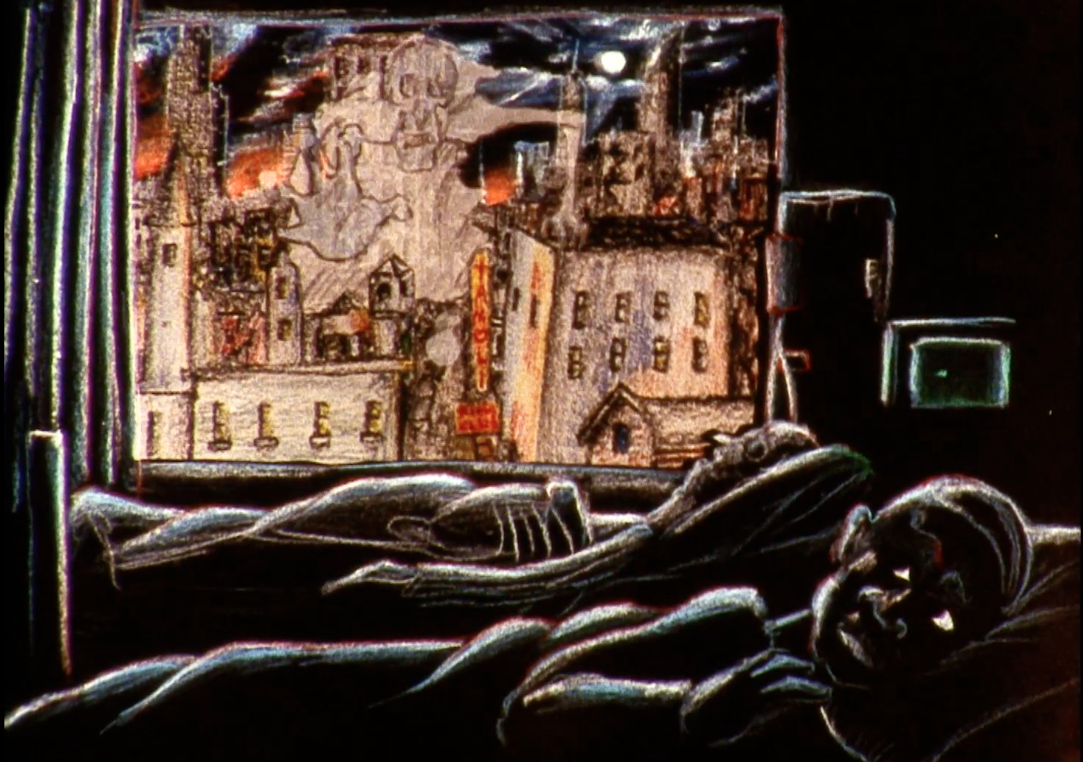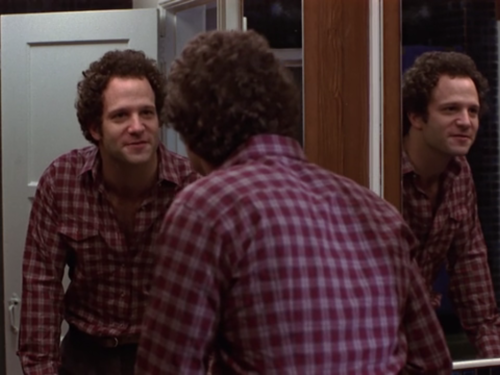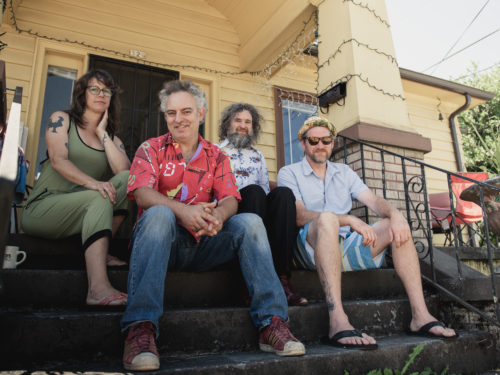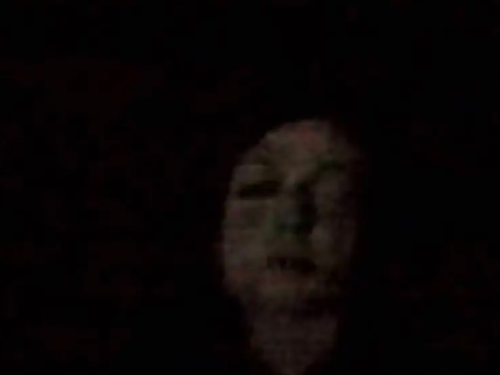The Chicago animator discusses distorting space and time in his work and why he hopes his films are like crime scenes
Chris Sullivan is an animator, filmmaker, and performance artist known for his macabre animated films. Drawn in a fluid, shape-shifting style, his short films — Ain’t Misbehavin! (1981), The Beholder (1983), Master of Ceremonies (1987), and Landscape with the Fall of Icarus (1992) — follow an array of troubled characters: a neurotic priest whose mind is crumbling like the decrepit church he worships in; a frothing street preacher who screams the gospel at passersby; and skeletons who juggle flaming torches, setting houses ablaze, while a grim reaper stalks the landscape. Each space in Sullivan’s work feels like it is on the edge of either disintegration or explosion. These tense atmospheres amplify the impact of his technique, where perspective and scale can shift at will.
His first feature film, 2012’s Consuming Spirits, took 15 years to create. In a decaying Rust Belt town, a group of down-on-their-luck characters struggle through their solitary existences. Present time is depicted through grotesquely painted stop-motion paper cutouts that exude a vivid social realism. The past is embodied through detailed 2D pencil animation that flows smoothly across the frame. Each character’s past weighs them down within a decrepit environment that envelopes them with a grim color palette.
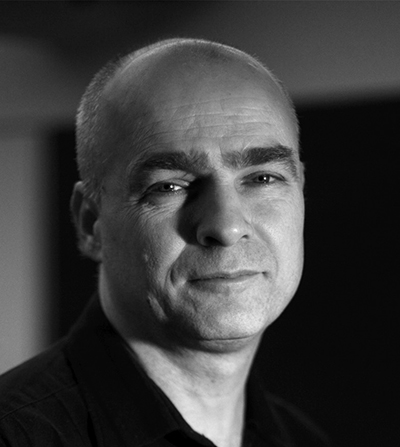
Sullivan also teaches at the School of the Art Institute of Chicago. He is currently working on his newest feature, The Orbit of Minor Satellites. It is a mix of live action and animation, and was built around old sound recordings of legendary actor Boris Karloff. The film is currently expected to have a fall 2021 premiere, but Sullivan is willing to hold out for as long as it takes to show the film live at festivals and in theaters.
We caught up with Chris Sullivan to speak about pushing cinema through the poetics of live performance, the shadow of death, and much more.
Split Tooth Media: You have previously said that you ‘hope your work is like uncovering a crime scene’ and that your films are ‘tampered evidence.’ Tell me more about this idea.
Chris Sullivan: I am not that interested in what people would call classical Hollywood tropes, like, ‘Will he get what he wants?’ The object of desire is something I like to keep blurry in the work in a lot of ways. I feel like that is how life is. You think you know what you want, but more things fall in front of you or fall away from you. As you try to articulate ideas, memory-based, or even if they are historical, they get kind of damaged in delivery. The classic theory is, ‘who’s behind the camera, who’s in front of the camera,’ but I think it is a little bit more like trying to translate some emotional or intellectual or psychological space into something. As it becomes manifested it changes into something else. It’s like evidence on the table and you see if you can put it together.
You’ve also spoken about the differences between cinema and theater and how you want to bring the poetics of live performance into your films.
It is kind of a struggle I have. I do performance work — I don’t do it as much anymore just because there is only so much time in one’s life. The last piece I did was two years ago, maybe even more. It is a very different thing than animation. I write it in a couple months, I prepare for a month, I make the props for a month, we perform it for a month, then it’s gone. But what is surprising about the stage is that you can have different kinds of authorial languages. You can suddenly on stage say, ‘I’ve been thinking about this thing that happened to me when I was young.’ If you did it on film it’s like, what’s going on? There is a lot more latitude in performance. The last performance I did, I read from these various poems every once in a while. I would pick up this thing and read it. And it made sense in theater, but it would not make sense on the screen. I am trying to push that a little bit because I am not that interested in normative dialogue.
But there are problems. I remember when people saw drafts of Consuming Spirits, and sometimes they said, ‘So you are not using professional actors?’ And I’m like, ‘No, I’m not.’ But I realized they were saying it like these actors are not professional. But when people actually watch the whole thing, [the actors] are often performing language. I really like their performances. For instance, I do not think Daniel Day Lewis is particularly believable. Most people would say he is an incredible actor, but I don’t buy it for a minute! I like language and I want to push film to a place where you can do strange things, expository monologues, and somehow have the audience accept things like that. But it is hard. One of my performers once as we were shooting my new film, The Orbit of Minor Satellites, I said, ‘Kind of say it like this,’ and they said, ‘Yeah, like a robot?’ I didn’t realize that they felt like the writing is really weird and robotic. It is a struggle but it is something I am excited by.
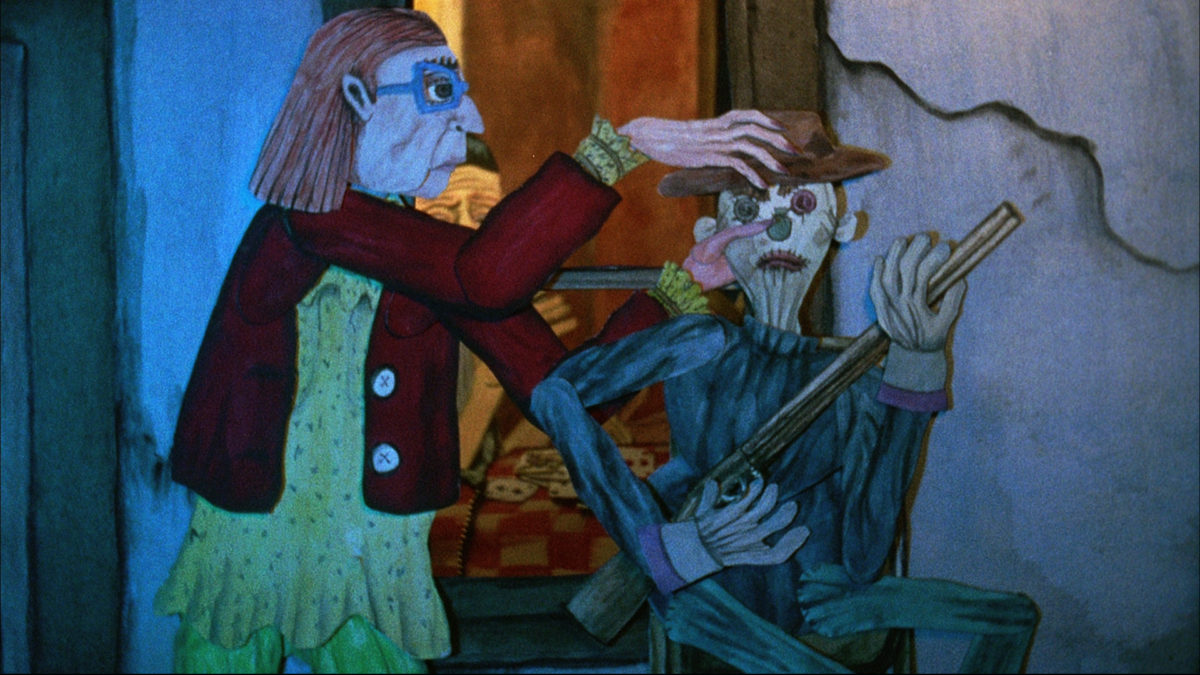
Speaking about performance, too, I know John Cassavetes is a big influence for you. Can you talk more about his influence on your work?
One thing that we really share is this idea that the social rituals of life are painfully revealing. John Cassavetes and Joe Frank are two of my very favorites. There’s a famous Joe Frank line, ‘Which is sadder, a funeral or a wedding?’, which I actually used in Consuming Spirits because I loved it so much. But in John Cassavetes, it’s a party, bad things are going to happen; it’s a dinner, bad things are going to happen; it’s lovemaking, etc. Recently there was a documentary of my favorite film of his, which is Love Streams. It just appeared on YouTube. It’s amazing. He talks a lot about what he wants to do in these films. It’s interesting because he says, ‘People are interested in politics; I’m just interested in love. That’s it. That’s all I care about.’ He trusts the fact that his characters are not necessarily loveable people, but maybe they are forgivable people. Love Streams is a little bit of a slow boil, but the last 45 minutes are magical. The last half an hour of most Cassavetes films you feel like there is a disintegration, it kind of whimpers out. From Faces to A Woman Under the Influence. But Love Streams really builds to an amazing thing. It builds to this crazy dream opera. That gave me some of this bravery to do things like the musical numbers that are in my films. A lot of that came from Love Streams and seeing how that felt in his films.
How do you approach designing and directing the voice acting in your films, and even performing yourself?
I want there to be a sense of a little bit of a breakdown. It is very interesting that in a Hollywood movie, a breakup looks like, ‘Sure you know what you want, but what about me? What about my life?’ But what a break up really looks like is this, ‘Well, yeah, I don’t know, I’ve just been thinking that, uh…’ It’s very quiet. There’s the Earl Gray character [in Consuming Spirits], who’s [voiced by] a friend of mine, [Robert Levy]. The way I would [direct him] was line by line. He would read it, but often I would give these very strange directions like, ‘Say this like you are trying to convince yourself.’
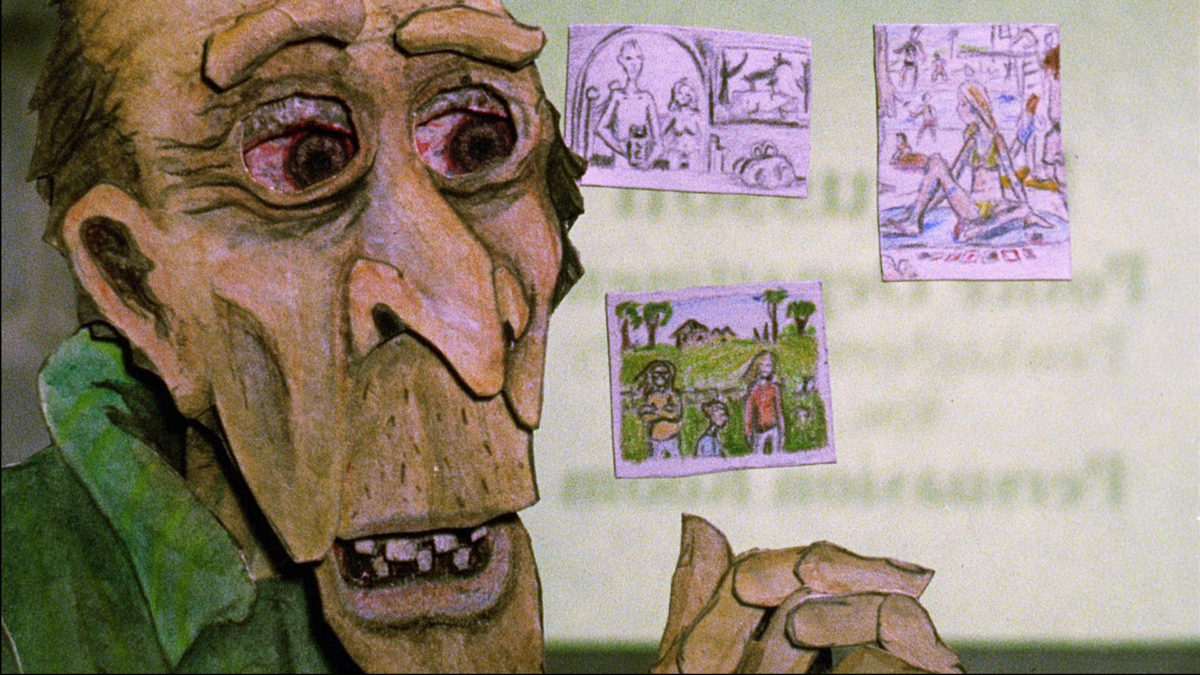
I loved the decision to use Boris Karloff recordings in The Orbit of Minor Satellites, can you talk about that choice and how you started to develop the film?
I was actually drawing this character, this buffalo that exists in the film. It has many different weird origins. One of the origins is this book called The Autobiography of a Schizophrenic Girl (Marguerite Sèchehaye, 1951). In this book this girl has this certain kind of hebephrenic schizophrenia, which is that she imagines there’s this planet that is operating her decisions. So I kind of created that in this narrative. But I was just sitting there drawing this buffalo and I was listening to these radio shows. I drew this one buffalo that looked exactly like Boris Karloff, and then I was hearing his voice. Then at the moment he said this thing that is in the film: ‘My name, I don’t know my name! I don’t know!’ And I just played it next to the video and was like, ‘Yes! This is what I’m doing.’
So I started writing around what he would say. So the other characters say things that feed into what he says. What’s been interesting, though, is that there are certain kinds of weird, almost prophetic things that seem to happen where I will set something and then I will find something that matches. I got out of the radio plays and I started going into some of his television dramas. He just said some things that were so perfect. He even said the character’s name: ‘That’s the story of Ruth. Life as a teenager is difficult.’ He is just saying all of these bizarre things.
I was working on it for six years before I actually asked permission. I found out the person I had to ask was his daughter, Sara Karloff, and it was a very scary moment of sending [that] email. But she gave me this really positive thing saying you have my blessing. So I was like, ‘Oh my god!’ Totally intense.

How did you decide to mix live action and animation in The Orbit of Minor Satellites?
I think pretty early I had this idea that this therapist’s office would be a lot to animate. But then I thought of having this inverse where the rest of the world is animated and this one therapist’s office is the only unanimated thing. Part of it was I wanted the kind of human tone of the performers. I thought it would be interesting if we’re not sure which is the fantasy. Almost like the Wizard of Oz thing. Is there really an Oz or was she asleep that whole time? There is this transitional scene where they change from animated characters to live action characters, and they go up these stairs.
One interesting thing, though, is that I realized the mistakes that I made. So as recently as a few months ago we did a big table read where we read some things that were missing. I am right now trying to figure out how to put those things in because I didn’t film them; I just got the audio. I do like the idea that you can go back into a film and you can change it, which is easier to do with animation than it is for live action. It’s kind of like, it is not done until it’s working, and that might mean you just have to go and do something. I have this thing when I teach where I say, ‘I wish that good filmmakers had the energy of bad filmmakers.’ Bad filmmakers, if they want a car to blow up, they are going to blow it up. And for artsy students, ‘Oh, I don’t know. It’s raining.’ (laughs) ‘I thought it would actually be interesting to not see that car blow up.’

Could you talk about beginning in animation and developing your own style of 2D animation?
A lot of it is accidental. One thing about animation is that it is a medium that allows you to do things that you did when you were in high school and become an artist.
There are times when I feel like I would like to be more painterly. I find that once I start doing the thing I get kind of contour-like, very closed shapes. But maybe there is something that is closer to reality that works in its own way. I guess there is always a trade off. I find if you have a super painterly, sketchy style, it is fine until people start speaking, and then you’re like, ‘What’s all over their face?’ But as long as you have silent characters moving about it looks fine.
You often mix different modes of animation in your films — pencil sketches, paper cutouts, etc. Can you tell me about this drive to blend styles and materials together?
Part of that, using different materials, is that it does shake up the patterns of the film and the tense of the film. But it has a downside, too. I often talk about this when I teach. What are the pros and cons of homogeneous versus heterogeneous materials? Do you want to draw attention to the construction of what you are doing? There’s less movement [between materials] with Minor Satellites. It’s all black and white. I played with color at one point, and then I changed my mind. But also I do have table top stuff in there. I don’t think I’ve shown much of that. I still have these two table top sets and I have characters in windows and stuff like that.
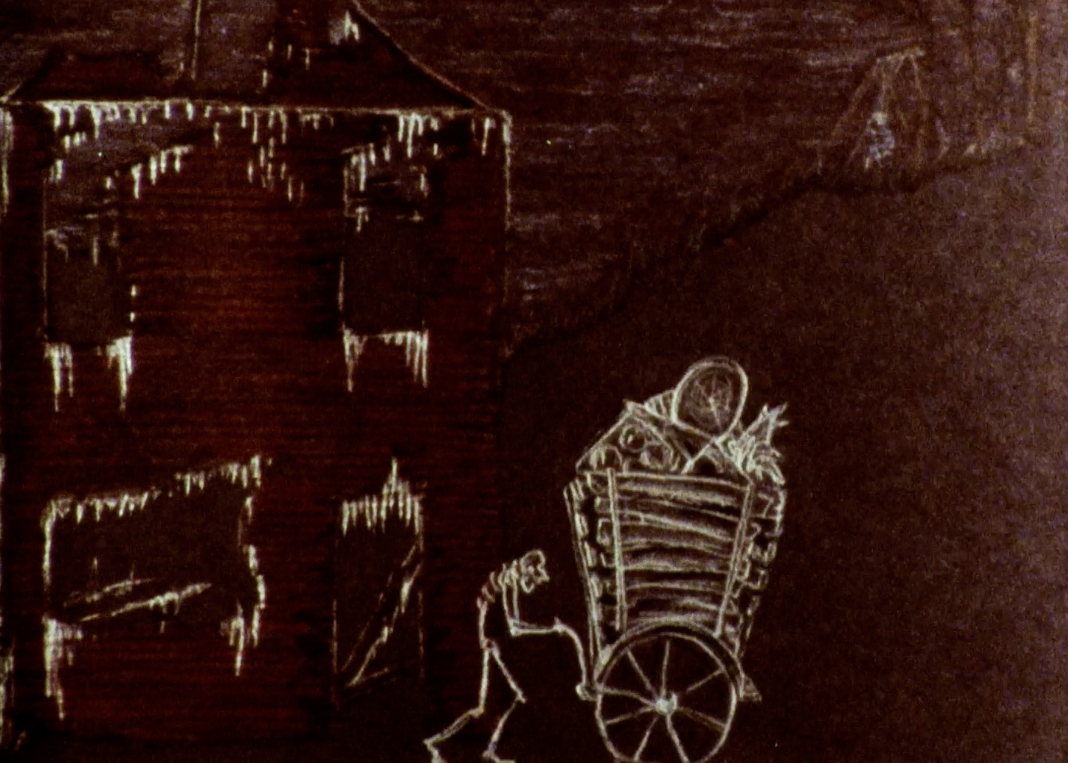
How does perspective and scale factor into your work? Space seems to expand and contract at will, where characters run between the foreground and background seamlessly. The sense of scale modulates so vividly in these moments of forced perspective.
There is a way where you can distort space and time. Part of it is you can make somebody just walk across a yard in four steps, just because it is kind of flat and kind of not flat. I like to work with landscape a lot. I am trying to work with it more. It is funny because even though you make an aesthetic choice, it is almost like you have to do this intellectual affirmative action, like, ‘You will make a landscape shot today!’ I still find that I’ll have a bunch of medium shots and I won’t have a lot of extreme close ups, so I have to force myself to do that. But there is something about figures in landscape, particularly in animation, that works differently than it does in live action. I don’t know why that is. Maybe it is because you are looking at it like a painting. But you can have this tiny figure in animation, and people are like, ‘That’s cool.’ But if you have your actor there they are like, ‘Come on, come closer. I can’t see you!’
I like the idea of somebody being dwarfed by their landscape and dwarfed by the enormity of things. It’s funny because Landscape with the Fall of Icarus is of course about that in terms of some death lost in the landscape. But even in this film, The Orbit of Minor Satellites, a minor satellite means it is not a moon; it is something a little smaller. I am tapping into this idea of facing existential invisibility.
How do you want to present your worlds, particularly in regards to social realism? How do you want to present the portrait of the places in your imagined worlds?
I am interested in landscapes that you can get lost in. Like Landscape with the Fall of Icarus or Consuming Spirits are these small industrial places, the Akrons, the Youngstowns of the world. I do like the idea of social realism and bending into magical realism. I tend to do mild historical fiction, maybe I’ll back up 20 years. Part of that is giving me a little bit of breathing space. I have some historical events that are in my new film. So to make the characters the right age I had to make it take place in the 1970s. The Orbit of Minor Satellites, it was abstract exactly where it was. I eventually decided that it was in fact Chicago. That had to do with all of these Chicago disasters that were part of its narrative. I found five appropriate disasters and three of them were in Chicago, so I was like, ‘OK, I’ll just shoot it in my own city.’ There is the Collinwood Fire, which is outside of Cleveland, Ohio, that killed like 170 kids. So my character lives in the Collinwood condominiums, which is a converted elementary school with the top floor burnt out.
I want the histories of these places to dwarf the characters. Although I’m very much into micro politics of families and individuals. The places are supposed to be places that the characters inhabit, but the characters can get lost in as well.
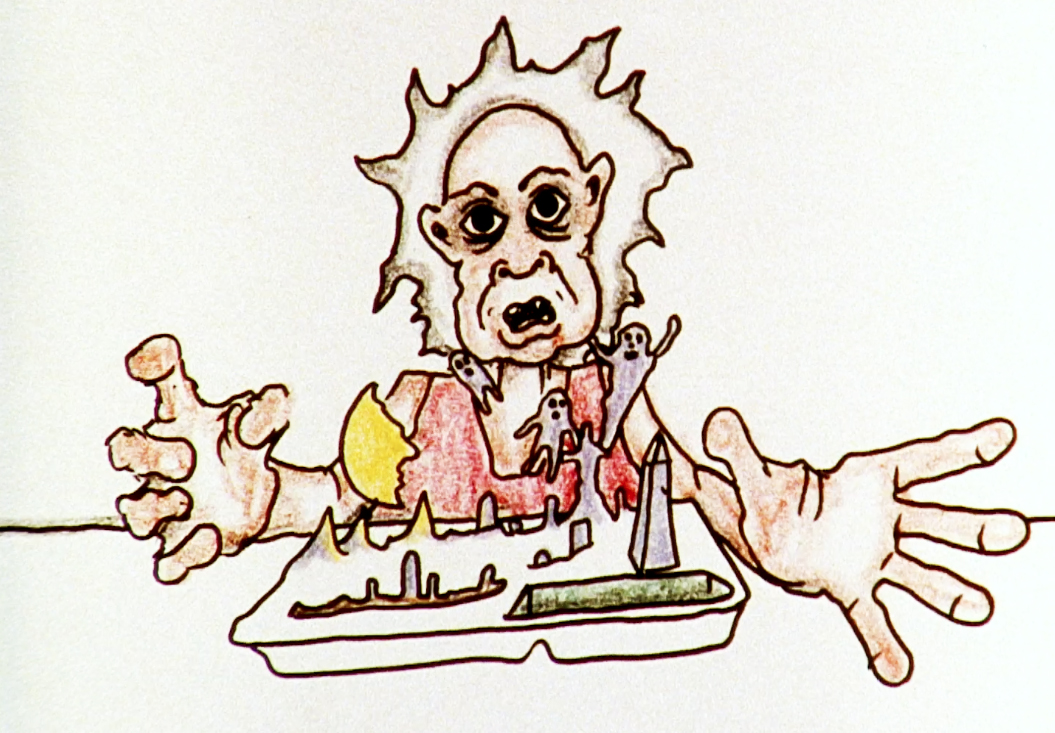
How do you approach memory in your films?
I like the idea that memory is somehow prophetic, or is a somewhat self-fulfilling prophecy in terms of where someone goes with the direction of one’s life.
I sometimes feel like I will plant a seed and then realize I haven’t really watered it. There are also memories I don’t have. The Orbit of Minor Satellites in many ways stems from a family horror that happened six years before I was born. This was Franny, my sister, who was hit by a car in front of the house and killed. It was my other older brother who was with her who crossed the street, and she followed. So the older he gets the worse that feeling of, ‘I did this,’ or ‘I was a part of this,’ gets. You think that it would get better, but I sense in him it gets worse and worse. So it is also this idea that maybe if he just says, ‘I am guilty, it is my fault,’ it actually might be a great relief. So I thought of this idea of someone saying like, ‘I am the reason why this happened, I set the house on fire.’ That catharsis of truth. These are the kinds of things that happen with memory. One thing that is interesting about living is you think you know the whole story, but you never do. At 60 I will still find out new things that I didn’t know, either about my own life or about my own relationships, or about my actual family relationships. I look at memory as this kind of thing that, I don’t completely agree that it’s not passed, I think it is passed, but it still sticks it’s head out.
Tell me about these reaper figures in your work and dealing with them from film to film.
They are probably pretty immature! But I think that it is almost like a recurring motif. I think there may not be an actual reaper in the new film, but I am not sure. I do think of that notion of the shadow of death, the notion of death being somewhere around the corner. In my garage there’s a painting I made in 11th grade, which is a big grim reaper playing golf with scythes.
[When] I was going through cancer stuff, I kept feeling that death is right outside the window or right inside the door. Now I feel like death is just in the neighborhood. I’m doing better now. The grim reaper is a wonderful notion — that he has planted you, therefore he is allowed to sow you. If you think that he’s this kind of God extension it’s not so bad. If you believe in that stuff, which I don’t! (laughs) I believe in oblivion.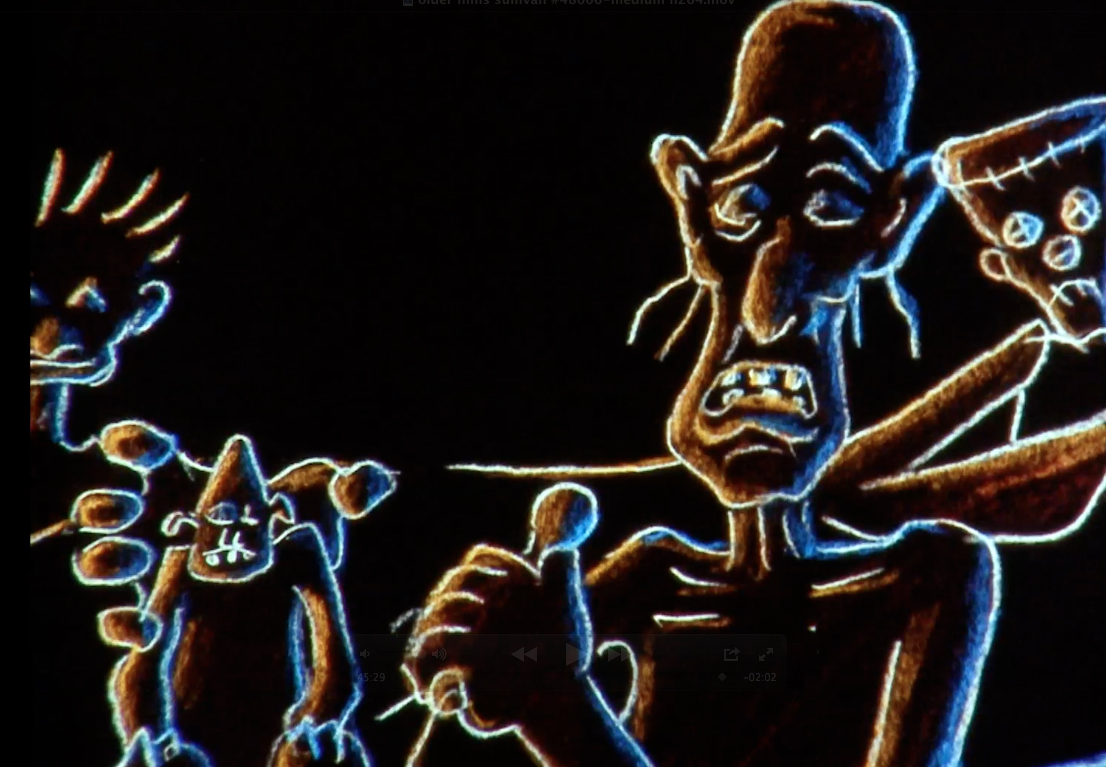
Your films often prominently feature religious spaces. Could you tell me about those presentations as well?
I think that my relationship with religion and iconography and Catholicism is a big part of my work. There is another weird side to it where there was a degree of sanctuary with being in church, even when I didn’t want to be in there. But it was a place where you were quiet and you were still. That’s what I did in elementary school. Whatever girl was beautiful that I would be fantasizing about my life with in the pew next door or whatever, very immature childish things. But there was a quiet there. I didn’t really believe in this God but maybe I believe in this quiet, and I don’t mind the incense. A lot of religion is about fear of death. I’m 60 now, and I have had some health stuff go on, so if things go very well I will live to be 80, but I am not going to be a 95-year-old walking around. But I do realize that you kind of just run out of time. One of the themes of [Minor Satellites] is that a short life is worth living. I am thinking about it to the very extreme, like my sister Franny, who died at 3. That it is still a life, just not the intended one. I’ve had quite a few college friends die and one just died of brain cancer. It was like, from diagnosis to death was like five months, with outrageous treatment. Of course in the end he realized he shouldn’t have done any of the treatment. They went inside, opened his head, and said, ‘No, it’s too big.’
Anne Sexton wrote a poem called, ‘Mercy for the Greedy.‘ There’s a wonderful line in it after a friend gives her a cross and she tries wearing it on her chest. She wants to be able to use it, but she says, ‘But I can’t. Need is not quite belief.’ So it is this interesting thought where, yeah, you may want that God, but if you don’t believe in it you just can’t make it happen. So these kinds of moments show how we acknowledge that religions are funnels for you to acknowledge death. If everyone really believed in heaven they wouldn’t be all crying at the funeral! They would be like, ‘Woo!’ (laughs) But I think if I accept my agnosticism, and my atheism, I also have to accept my oblivion and my end.
Many of Chris Sullivan’s films are available on his Vimeo
Rent Consuming Spirits here
Find more information about The Orbit of Minor Satellites here
Stay up to date with all things Split Tooth Media and follow Robert on Twitter
(Split Tooth may earn a commission from purchases made through affiliate links on our site.)

